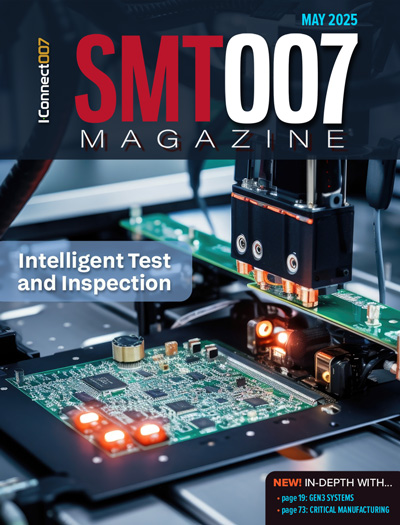-

- News
- Books
Featured Books
- smt007 Magazine
Latest Issues
Current Issue
What's Your Sweet Spot?
Are you in a niche that’s growing or shrinking? Is it time to reassess and refocus? We spotlight companies thriving by redefining or reinforcing their niche. What are their insights?

Moving Forward With Confidence
In this issue, we focus on sales and quoting, workforce training, new IPC leadership in the U.S. and Canada, the effects of tariffs, CFX standards, and much more—all designed to provide perspective as you move through the cloud bank of today's shifting economic market.

Intelligent Test and Inspection
Are you ready to explore the cutting-edge advancements shaping the electronics manufacturing industry? The May 2025 issue of SMT007 Magazine is packed with insights, innovations, and expert perspectives that you won’t want to miss.
- Articles
- Columns
- Links
- Media kit
||| MENU - smt007 Magazine
Digicom Electronics Upgrades Medical Device Quality Certification to ISO 13485:2016
November 27, 2018 | Digicom ElectronicsEstimated reading time: 2 minutes
Digicom Electronics, Inc. has upgraded its medical quality device certification to ISO 13485:2016. The ISO 13485 standard is a series of requirements that help device makers develop a quality management system to ensure the quality, safety, and effectiveness of the medical devices they manufacture. Digicom specializes in complex products and those that require the utmost precision, reliability, durability, and enhanced performance.
Digicom's Diamond Track Process helps medical device companies with their complete process, from design for manufacturing to fully integrated box build systems. Digicom handles both small runs and high-volume manufacturing and produces the prototype, sources the components, manufactures and tests the product, assists with process validation, and ships the product directly to its end user.
To eliminate device failure from PCB contamination, Digicom uses a proprietary process to clean circuit boards. It removes ion contamination to below detectable levels and results in PCBs that far exceed IPC-TM-650 cleanliness standards. Digicom also manufactures its own nitrogen and pipes it to its manual, reflow, and selective soldering processes to help strengthen the bonds and improve adhesion in the soldering process.
"Manufacturers of medical devices must seek every way possible to eliminate failures of those devices," explained Mo Ohady, general manager of Digicom Electronics. "Many major failures result from a weakness in the solder joint that connects the wire bond to the printed circuit board, the solder that connects the device or package to the board, or board contamination. That's why we spent years developing our cleaning process and implementing a nitrogen system. Using nitrogen is not an absolute requirement; however, among other things, nitrogen can help to strengthen the bond and improve solder adhesion in the soldering process."
Digicom experts will be available at the BIOMEDevice Show, San Jose, CA, on December 5 and 6, in booth 433, to discuss your electronic manufacturing and assembly needs.
Digicom is a certified small business and HUBZone with AS9100:2016 (Rev D) aerospace, ISO 9001:2015, ISO 13485:2016 medical devices quality, quality system regulation 21 CFR 820, and ITAR certifications.
About Digicom Electronics
Digicom Electronics offers advanced electronics manufacturing with "Made in the USA" quality that fits the needs of larger enterprises while at the same time providing the benefits and individual attention needed to serve start-up companies. Digicom collaborates in all aspects of the process from the design for manufacturability to the final, fully compliant product. Material procurement and management services include planning, purchasing, expediting, and warehousing of components and materials. Digicom has been manufacturing in the California Bay Area since 1982. It is a certified small business and HUBZone with AS9100:2016 (Rev D) aerospace, ISO 9001:2015, ISO 13485:2016 medical devices quality, quality system regulation 21 CFR 820, and ITAR certifications.
Suggested Items
Driving Innovation: Direct Imaging vs. Conventional Exposure
07/01/2025 | Simon Khesin -- Column: Driving InnovationMy first camera used Kodak film. I even experimented with developing photos in the bathroom, though I usually dropped the film off at a Kodak center and received the prints two weeks later, only to discover that some images were out of focus or poorly framed. Today, every smartphone contains a high-quality camera capable of producing stunning images instantly.
Hands-On Demos Now Available for Apollo Seiko’s EF and AF Selective Soldering Lines
06/30/2025 | Apollo SeikoApollo Seiko, a leading innovator in soldering technology, is excited to spotlight its expanded lineup of EF and AF Series Selective Soldering Systems, now available for live demonstrations in its newly dedicated demo room.
Indium Corporation Expert to Present on Automotive and Industrial Solder Bonding Solutions at Global Electronics Association Workshop
06/26/2025 | IndiumIndium Corporation Principal Engineer, Advanced Materials, Andy Mackie, Ph.D., MSc, will deliver a technical presentation on innovative solder bonding solutions for automotive and industrial applications at the Global Electronics A
Fresh PCB Concepts: Assembly Challenges with Micro Components and Standard Solder Mask Practices
06/26/2025 | Team NCAB -- Column: Fresh PCB ConceptsMicro components have redefined what is possible in PCB design. With package sizes like 01005 and 0201 becoming more common in high-density layouts, designers are now expected to pack more performance into smaller spaces than ever before. While these advancements support miniaturization and functionality, they introduce new assembly challenges, particularly with traditional solder mask and legend application processes.
Knocking Down the Bone Pile: Tin Whisker Mitigation in Aerospace Applications, Part 3
06/25/2025 | Nash Bell -- Column: Knocking Down the Bone PileTin whiskers are slender, hair-like metallic growths that can develop on the surface of tin-plated electronic components. Typically measuring a few micrometers in diameter and growing several millimeters in length, they form through an electrochemical process influenced by environmental factors such as temperature variations, mechanical or compressive stress, and the aging of solder alloys.


